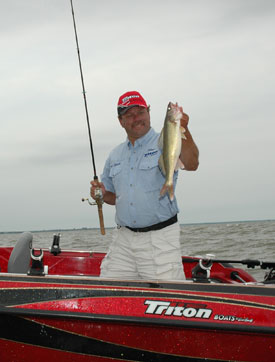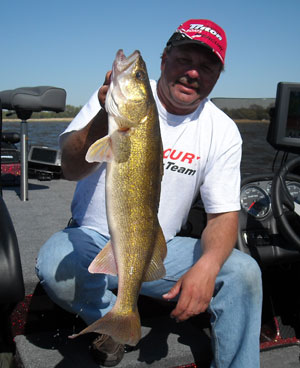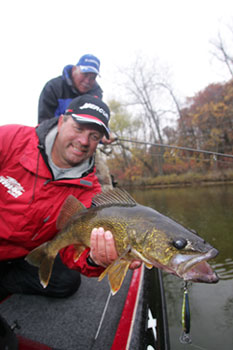Navigating the open-water walleye season is like competing in an off-road race.
When the terrain is extreme, progress is best made slowly. Some stretches may provide opportunities to crack open the throttle for a few seconds. And when the course opens up and flattens out, it’s time to put the pedal to the metal.

Early in the walleye season when water temperatures are cold, we creep along at a snail’s pace as we attempt to give our prey every opportunity to see, sense and react to what we have to offer. By late spring, we’re generally moving a little faster as the fish disperse throughout a lake or river in search of easy meals.
Summer is the home stretch. It’s the moment of truth. It’s what separates the pooches from the big dogs. And many times, that means either pick up the pace or go home empty-handed.
You will recognize the signs.
It’s probably hot enough to fry an egg on the hood of your outboard. Water temperatures have surpassed the 70-degree mark. There are more people in the water than on it.
Trolling crankbaits at 2 or 2 1/2 mph isn’t triggering many strikes. Pulling spinner and crawler rigs isn’t putting fish in the boat, either. Changing crankbait styles or blade colors isn’t making a difference.
Sometimes, the signs are far more obvious. Another angler passes you and nets a fish. Or maybe you catch a walleye as you make a turn and your Off-Shore planer boards speed up on one side of the boat.
Most of the time, however, it’s more a matter of changing things up when you aren’t experiencing the results you desire, and speed is one of the best ways to trigger warm-weather reaction strikes when the bite is tough.

There are probably several reasons why walleyes react to faster-moving baits this time of year.
First of all, forage is abundant with young-of-the-year baitfish reaching edible size and supplementing the population of adult shad, alewifes, shiners, smelt, chubs or minnows. Walleyes can eat almost any time they desire, and the windows of opportunity when an angler can fool them with artificial baits are smaller.
Secondly, walleyes are simply more active. Their metabolism is running like a furnace on the coldest days of winter. They cover a lot of water and burn a lot of energy.
Thirdly, a lot of walleyes suspend in open water or lurk along breaklines where schools of these baitfish roam. That means they are more willing to chase a lure than they might be when they were hugging the bottom relating to specific structure.
There are some keys to making the speed game work in your favor.
Sometimes, we know where the walleyes are hanging out based on word of mouth or the location of other anglers. Other times, I like to study my Navionics maps and pick out likely areas based on factors like deep contour changes, underwater structure, nearby vegetation or the makeup of the bottom.
Electronics are important when considering new locations. I keep a close eye on my Humminbird unit and look for baitfish with the occasional hook mixed in here and there before I set lines and begin a troll. If the fish are suspended just under the surface, they may shy away from my Triton 215X as I approach, but Humminbird’s side imaging technology helps me locate them.
As a general rule, I target the area several feet above these fish. Because they are more active and because I am trying to evoke a reaction strike in what is usually clear water, they will come and get it if they want it.
My trolling rods are 8 1/2-footers with fairly soft tips. Coupled with 10-pound monofilament line, there is enough give and stretch in this set-up to help me fight and land fish hooked far from the boat on my Off-Shore boards.

As for baits, while you want to “match the hatch” so to speak in terms of trying to emulate the dominant baitfish species, you also want your crankbait to stand apart.
Pick a style of bait that runs well at higher speeds. Generally, these are shorter lures with shad-type bodies that produce a tight, aggressive wobble. I also make sure my spread includes a crank or two with rattles because I’ve experienced plenty of situations where it’s made all the difference.
Pick a color pattern that’s slightly different than the forage on which the walleyes are feeding. If they’re on a shad bite, a silver and blue crankbait might stand out enough get their attention. If they’re feeding on perch, it might be a firetiger pattern that trips their trigger.
Tuning crankbaits is critical. With four or five feet of line hanging from the end of your rod, drop your lure in the water and rip it forward. If it kicks out to one side or the other, use a pair of needle-nosed pliars to slightly bend the eye on the lure until you get it to run true at high speed.
If you are in open water, troll in a zig-zag pattern to change the speed of your lures. When I’m trying to target a specific breakline, edge or transition, I alter my speed with my Mercury 9.9 hp Pro Kicker. Often, these changes in speed trigger strikes, and sometimes that tells me I need to add more speed across the board.
How much speed is too much? That’s a hard question to answer. Sometimes, the difference between 2 mph and 3 mph is enough to change your fortunes. Sometimes, 4 mph could be the magic number. The fish will let you know.
Speed-trolling isn’t limited strictly to crankbaits. I’ve picked up the pace to as much as 2 1/2 mph with crawler harnesses to catch fish. I know Great Lakes anglers who pull spoons at 3-4 mph behind Dipsey Divers and downriggers with great success.
Keep a watchful eye behind your boards, too. If your lures pick up any debris, they will come to the surface at higher speeds. And if a lure does foul, get it cleaned off quickly or you could encounter line twist so severe you’ll have a problem with that rod the rest of the day.
We all have a need for speed. Sooner or later, our summer bites will bog down. Shift gears and pull into the fast lane. The race is on.










